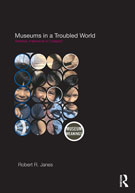review by J Patrick Greene

Passion is not necessarily the characteristic one would associate with books on museology, but in this volume it is there in abundance and in consequence it makes for a stimulating and at times exasperating read. Robert Janes, who edits Museum Management and Curatorship, is a museum consultant and was formerly president and chief executive officer of the Glenbow Museum in Canada. At an earlier stage of his career he worked with native peoples in the far north of Canada and that is where his book begins, with a parable based on the Great Council of the Animals that culminates in a decidedly jaundiced view of mankind. Janes is no less critical of museums that, in his view, have generally failed to respond to the challenges of the 'troubled world' of his title. Armed conflict, destruction of species and habitats, assaults on cultural diversity, money as the measure of worth, unsustainable consumption are all characteristics of his troubled world. A combination of a 'tyranny of tradition', conservatism, subservience to the marketplace, elitism and management myopia are seen by Janes as the ingredients that have caused museums to be unwilling to address issues confronting us today. There are other factors, too, such as the 'lone chief on top of the organizational chart', arrogance (he cites in particular the Declaration on the Importance and Value of Universal Museums), vanity architecture, an obsession with blockbuster exhibitions, neoclassical economics and a failure to communicate. It's a very personal book, which Janes invests with his own experiences among the Willow Lake hunters in northern Canada whom he admires for their self-organisation, and as director of the Glenbow Museum from which he still bears the scars.
There are some big gaps that compromise the impact of the book. Janes himself states that his experience is drawn primarily from North America and his travelling or reading beyond the continent appears limited. Australian readers will have to content themselves with an example from the National Museum of Australia (the Murray–Darling Outreach Project) and work by Fiona Cameron on presenting controversy, both cited with approbation. There is little from Europe, although the United Kingdom's Museum Association's activities such as initiatives on sustainability and diversity in the workforce come in for praise. The biggest blind spot concerns the internet. In a review of Museum Management and Marketing (2007) in reCollections (vol. 2, no. 2) I noted the absence in the index of terms such as 'website', 'internet', 'world wide web' and 'search engine'. Janes was one of the editors. This time 'world wide web' does make an appearance, but in a section less than one page in length. Most museums have more visitors to their websites than through the door, so paying such little attention to museums' web content undermines the thesis of the book.
Museums in a Troubled World is more a polemic than a cool-headed analysis, and on almost every page my reaction was 'But why haven't you considered ...?' or 'Don't you know that ...?' Don't let that put you off, however, as this is a book well worth reading and it is also entertainingly written, with some achingly honest scenarios drawn from Janes's own experiences. Its intention is honourable and praiseworthy — to examine how far in our museums we meet the expectations and needs of our planet and its inhabitants. It may be a flawed mirror, but examining our reflection in it should encourage us to redouble our efforts to create, in Janes's words, 'a new breed of museums grounded in consciousness of the world around them — renouncing complacency and fulfilling their latent potential as community organizations of the highest order'.
J Patrick Greene is the chief executive officer of Museum Victoria.
